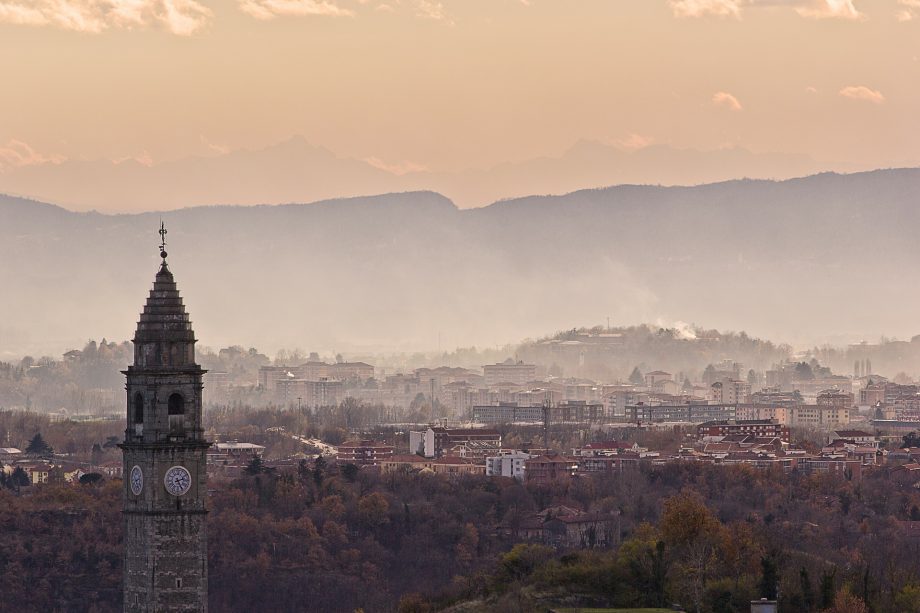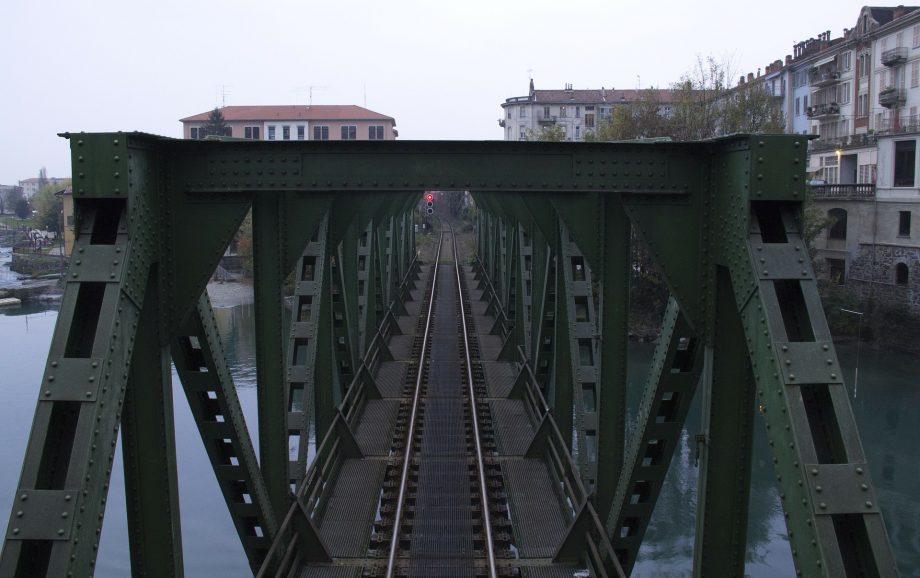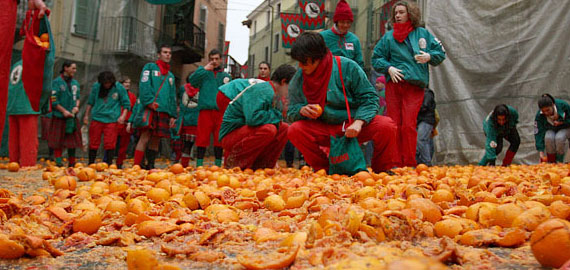Ivrea Italy

Beautifully picturesque Ivrea lies in north-west Italy, near Turin and although it is not typically a tourist trap, there are several interesting sights, most notably the cathedral and Roman ruins, which will keep you entranced. That, and the town’s annual carnival – the Battle of the Oranges
History of Ivrea, Italy
What we now know as Ivrea, was originally colonised by the Salassi, a group of people who lived in the present Canavese and Valle d’Aosta. Their main activities were the mining of iron, copper, gold and silver but sadly for them, they were on a strategic route for the Romans, who were marching towards Gaul. The Romans declared war on them and were ultimately victorious. In 100 BC, the Romans founded Eporedia in the region which then became a municipium. Due to the region’s hilly nature, the town of Eporedia was formed on an irregular pentagon, its main street is still the main street in today’s Ivrea.
After the Romans, Eporedia became the seat of a Longboard Duchy, then a county of a Frankish kingdom and in the 9th century it became the capital of its region. In the 13th century a massive castle was built, which still dominates the city to this day.
After the fall of Napoleon, the city returned to the Kingdom of Sardinia until 1859, where it remained the capital of the province. In the 19th century the city expanded and substantial transformations occurred. Gradually, over time, the city lost its medieval structure and in the early decades of the 20th century Ivrea became an important cog in the great wheel of the industrial revolution.
Visiting Ivrea
Piazza Castello and Ivrea castle – Work on the castle, with its four angular towers and large central courtyard, began in 1358 and was completed in 1395. In the 18th century the castle was transformed into a prison, a role that it held until 1970, when major renovations began.
Ivrea Cathedral – With its three naves, the cathedral has managed to hold onto several of its oldest features, which date back to the Cathedral of Warmondo. Despite the many renovations of the centuries, the cathedral has retained its history and charm. It does now have a semicircular apse and two bell towers of Romanesque style. The two towers are very similar to look at and have both been divided into several tiers, adorned with decorations and hanging arches, while the top of each side features open mullioned windows.
Beneath the church, the crypt was built in two stages. The oldest part is semi-circular and located under the apse, with cross vaults supported by columns. The most recent part of it dates back to the 12th century. In the crypt there is an ancient Roman marble sarcophagus that belonged to Quaestor Gaius Valerius Atecius (second half of the first century BC) which is very well preserved, and three tombs of the ancient Bishops of the city.
Ivrea Civic Museum – This is a museum dedicated to the scholar Peter Alexander Garda (1791-1880) and has a sizeable section of Eastern and Archaeological art, and a number of frescoes from the 15th and 17th century. The unexpected highlight has to be the Garda Collection of Oriental art: works collected by Peter Alexander Garda in the late 19th century and according to experts, it is one of the most important collections of Oriental art outside of Japan. It contains many archaeological finds, mainly dedicated to the colony of Eporedia and its origins. Also in the museum, are a wide selection of paintings from the 14th to 20th centuries, such as the Crucifixion by Giovanni del Biondo , Madonna with the Child, by Neri di Bicci and Christ removed from the cross, attributed to Ambrogio da Fossano.
Ivrea carnival – The Carnival in Ivrea includes the famous Battle of the Oranges. This lively event features 400 tonnes of oranges being thrown, over the three days preceding Ash Wednesday. It represents the overthrow of a tyrant in Ivrea in the 12th century. If you want to take part, you will have to pay a small fee; if you want to just watch, don a red cap and keep behind the net barriers!
Church of San Bernardino – This 15th century church has frescoes depicting events from the Life of Jesus. The oldest part of the church was build by the convent of the Franciscan order in the first half of the 15th century.
Day trips – Not far from Ivrea you can visit the Lake of Viverone, where remains have been found from the Bronze Age and is therefore now a popular tourist destination.
Eating out in Ivrea
No visit to Italy is complete until you have tried the local cuisine and this holds true in Ivrea. The food of Ivrea is typical of the Piedmont region, with the dishes based largely on rice. For many centuries rice was a vital source of food for the inhabitants of this region, and people have invented many ways to use it: from rice and duck, to rice with champagne and shrimp, to the Paniscia – a rice-soup with vegetables, bacon, beans, sausage, salami and wine.
- Brasati (Brasato al Barolo) – The famous braised meats of Southern Piedmont are cooked for hours with the prized red wines of the area (mainly Barolo). With an abundance of beef and barolo wine in the region, it is only natural that someone put two and two together! This dish is a luscious, tender, yet hearty stew, most suited to the inclement weather of the winter months.
- You can’t go to Piedmont without trying the white truffles.
- Bagna Caoda, or bagna cauda – This is a typical sauce made by slowly cooking garlic in milk, olive oil and butter with a late addition of anchovies. Served boiling hot, it is a dish that closely resembles a fondue. Enjoy this over raw vegetables like cauliflowers, carrots and peppers.
- Bollito Misto alla Piemontese – Translated literally, this means ‘boiled meats’, and it traditionally includes a wide range of beef cuts including tongue, oxtail and brisket, as well as chicken and pork meat. Each cut is boiled individually, since each requires a different time in the pot, then they are served with a variety of sauces, among which, the most famous is bagnetto verde – a parsley, garlic and olive oil sauce that marries wonderfully with all of the boiled meats.
- Agnolotti al Plin – This is a variation of the omnipresent ravioli that can be found throughout Italy. These local delicacies are stuffed with three types of meat (veal, pork and rabbit traditionally) and then closed with a pinch (the plin part of the name). They come served with a very simple sauce: butter and sage or the roast juices of arrosto.
Italian wine from the Piedmont region
We can’t talk about Italian food without talking about Italian wine, the two go hand in hand. Nowhere in Italy compares with the Piedmont region for travellers looking for a combination of fine wines, great food and stunning scenery. The area to explore is just an hour’s drive from Turin: from Bra, through Alba then Asti, and up to the Monferrato region. The road takes you through a vast array of vineyards, all responsible for producing Italy’s greatest red wines – Barolo, Barbaresco, Barbera – and whites, from Asti Spumante, Moscato and the little-known Arneis. The winemakers here tend to own small properties, held by the same family for several generations and they will usually welcome you in, to taste their wines in their cellars. Some also offer ‘agriturismo’ accommodation – where you basically get to stay on a working vineyard. You can also arrange for tours of the cantinas of the really famous producers. If you feel in need of some pampering for a couple of nights, there is a selection of castles, monasteries and mansions that have been converted into luxury hotels.
Would you like to go to Ivrea?
Get the best hotel, car hire and flight deals to Ivrea with The Global Circle Club
Already a member of The Global Circle Club? Login to your member account to get the best hotel, car hire and flight deals. Not a member yet? Sign up for free membership, no membership fees, no hidden fees, over 280,000 hotels worldwide where you can save up to 40% on hotel rates and more…


